Introducción
When you walk into the cinema, have you ever thought that the traditional projector will be replaced by a brand-new technology one day?
El pantalla LED is quietly changing the way we watch movies. Can it really completely replace the traditional projector? What are its advantages?
Tabla de contenido
1. What are the limitations of traditional projectors?
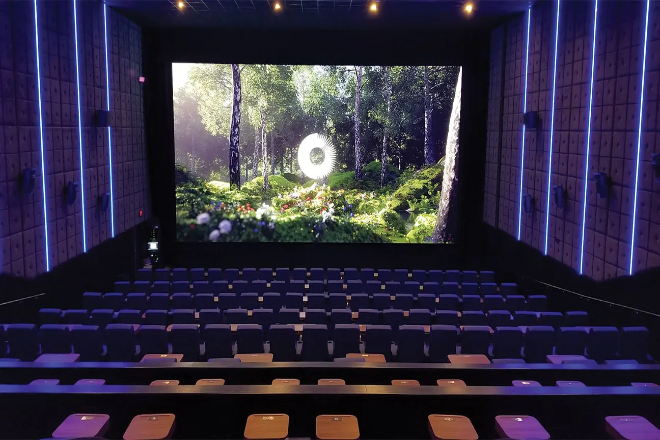
Traditional projectors use optical projection technology and rely on light bulbs to emit light. However, the brightness of light bulbs will gradually dim after a long time of use.
After hundreds of hours of use, the brightness may be reduced by 30% or even half, and the picture will become dimmer and dimmer, greatly reducing the viewing experience.
Moreover, the resolution of traditional projectors is not high.
The limitations of the optical system and imaging components make it impossible for them to display high-definition or even ultra-high-definition pictures like modern digital projectors.
The details look particularly blurred and grainy on the large screen.
The life of the bulb is also very short. Generally, it has to be replaced after 1,000 to 3,000 hours. For those cinemas that are used every day, the bulb may have to be replaced every few months.
This not only increases the cost but also is very troublesome because you need to find a professional to replace the bulb.
The optical system and mechanical parts of the projector also need to be maintained regularly.
The lens needs to be cleaned, the optical elements need to be calibrated, and the mechanical parts need to be replaced when they are worn.
These all require professional tools and equipment, and the maintenance cost goes up all of a sudden.
The traditional projector is indeed a bit unsatisfactory in terms of picture quality and colour.
In terms of contrast, it is difficult to handle the light and dark parts well. The black parts are not dark enough, and the bright parts are easily overexposed.
The picture has no sense of layering, especially those scenes with strong light and dark contrast, which are particularly uncomfortable to watch.
The colour saturation is not good, either. The colour is presented by optical filters and the spectrum of the bulb. As a result, the colour looks very bland and not bright enough.
For example, when watching natural scenery or cartoons, those pictures that should be colourful will appear particularly “plain” when played by traditional projectors.
Moreover, the uniformity of the picture of traditional projectors is also difficult to guarantee, and the edges are prone to dark corners or blurs.
Dark corners mean that the edge of the picture is much darker than the middle, and blur means that the edge part looks unclear.
These problems greatly reduce the quality of the entire picture, and the viewing experience is naturally not good.
Traditional projectors have particularly stringent requirements for the projection environment.
First of all, it requires a completely dark environment to make the picture look clear because its brightness is relatively low.
If there is light in the environment, the picture will be “flooded”, and the audience can’t see the content clearly.
This requires the theatre to install thick blackout curtains and seal the doors and windows well, which increases the construction and operation costs of the theatre.
In addition, the projection distance and angle of traditional projectors are also limited. If the projection distance is too short or too long, the picture will be distorted or blurred.
If the projection angle is not right, the picture quality will also be affected. During installation and debugging, the projection distance and angle must be accurately calculated.
The process is particularly complicated and requires professional personnel to operate.
If the installation location is not suitable, the equipment must be readjusted, which wastes time and energy.
2. Analysis of the advantages of LED display screens in cinemas
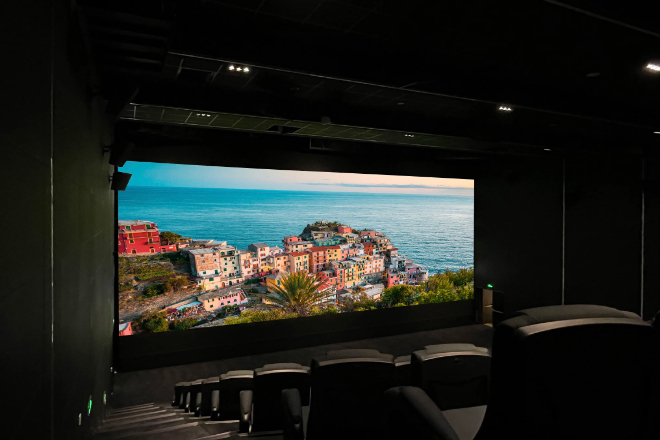
Imagine that you are watching a movie in a movie theatre, and suddenly, the lights come on, but the picture is still clear. This is the charm of an LED display!
El brillo of traditional projectors is not enough, and the picture is easy to dim, but the brightness of the LED display is amazingly high, which can easily reach twice or even more than that of traditional projectors.
In addition, the contrast is also super powerful. The contrast of traditional projectors is like black and white photos, and the layering is not enough, while the contrast of LED display can make the black of the picture blacker, the white whiter, and all the details can be seen clearly.
For example, when watching the dark scenes of “Batman”, the traditional projector may not let you see anything clearly, but the LED display can let you see every expression of Batman clearly, which is a great experience!
The colour in the movie is very important. Otherwise, the picture will be as ugly as a faded photo.
The LED display is particularly powerful in this regard, and it can restore the most realistic colours in the movie.
The colour gamut of traditional projectors is narrow, and the colours look a bit “grey”, but the LED display supports a wide colour gamut, and the colours are as bright as if they were just taken off the canvas.
For example, when watching the fantasy blue planet in “Avatar”, traditional projectors may make you feel that the colours are a bit fake, but LED displays can make you feel like you are on Pandora, with natural and realistic colours.
Moreover, no matter where you are in the theatre, the colours look the same, which is difficult to achieve with traditional projectors.
HDR technology is like adding a “super filter” to the picture so that the light and dark details of the picture can be perfectly presented.
Traditional projectors are a bit powerless in this regard, and the highlights are prone to overexposure, and the details of the dark parts are easily lost.
However, the HDR technology of LED displays can make the highlights of the picture sparkle, and the details of the dark parts can also be clearly seen.
For example, when watching the high-speed racing scenes in “Fast and Furious”, traditional projectors may make you feel that the picture is a bit blurry。
But LED displays can let you see every flying spark and the texture of the wheels clearly, and this sense of detail is simply irresistible!
In traditional cinemas, viewers sitting in the corner may feel that the picture is distorted or the colour is wrong.
However, the wide ángulo de visión of the LED display solves this problem. Its viewing angle can reach 160° or even wider, almost covering the entire theatre.
This means that no matter where you sit, the picture looks equally good.
For example, in a large theatre, the audience sitting in the last row can also enjoy the same viewing experience as the audience in the front row. This feeling of “golden seats for the whole audience” is great!
When watching a movie, the most uncomfortable thing is the picture freeze or blur.
El alto frecuencia de actualización of the LED display is like adding a “smoothing agent” to the picture, making the picture smooth like silky chocolate.
The refresh rate of traditional projectors is relatively low, and fast-moving scenes are prone to ghosting, but the high refresh rate of LED displays can keep the picture clear and smooth.
For example, when watching the superhero battle scene in “Avengers”, the traditional projector may make you feel that the picture is a bit stuck.
However, the LED display can make every move of the superheroes clearly visible, and this sense of smoothness takes the viewing experience to a higher level.
Traditional projectors require a dedicated projection room, which takes up a lot of space.
However, LED display screens can be installed directly in the theatre without the need for an additional machine room, and the space utilization is more flexible.
For example, the theatre can add a few more rows of seats to increase box office revenue.
Moreover, LED display screens can be installed on walls or ceilings and can be flexibly arranged according to the needs of the theatre. This flexibility makes the theatre’s space utilization more efficient.
LED display screens can not only play movies but also do many other things. For example, it can be used to host e-sports competitions, corporate events, live concerts, and even play advertisements.
In this way, the theatre can make money during non-movie viewing time and become a multifunctional commercial complex.
For example, e-sports competitions can be held on weekends to attract young audiences.
On weekdays, the venue can be rented to companies for activities to increase revenue.
This multifunctional feature makes the theatre’s operation more diversified and more competitive.
3. What is the current status of LED display screens in cinemas?
Now, LED display screens are no longer a rare thing in cinemas.
As early as 2018, Samsung opened the first Samsung Onyx LED Cinema in Shanghai.
Its ultra-clear 4K picture quality, high brillo and high contrast have brought a shocking experience to the audience.
Since then, the application of LED display screens in cinemas around the world has gradually increased.
As of mid-November 2024, more than 100 LED movie screens have been installed worldwide, of which 54 were installed in 2024.
These screens not only cover a variety of sizes and specifications but are also widely used in cinemas in different countries and regions.
Among the more well-known cinemas are:
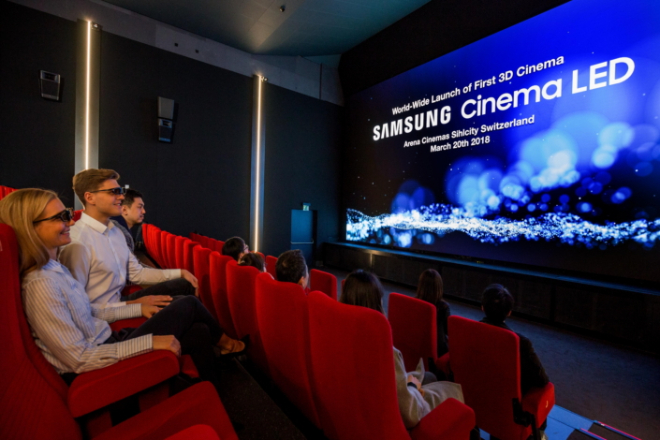
1). Samsung Onyx LED Cinema:
Samsung is a “leader” in this regard. The Onyx LED screen they developed not only has ultra-clear pictures but also has great sound effects.
For example, in some cinemas in Paris and the United States, audiences sit there watching movies and feel like they are in the scene.
This kind of screen is particularly suitable for special effects blockbusters, such as “Avatar”, where the details in the picture can be seen clearly.
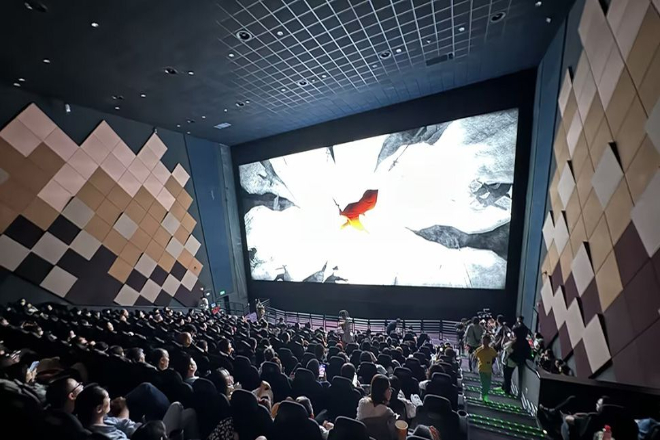
2). Lopu fully sound-transparent LED movie screen:
Lopu’s screen is also very powerful. It is not only sound-transparent but also perfectly cooperates with the sound system.
When the audience sits in the theatre, they can not only see super clear pictures but also hear stereo sounds coming from all directions. This experience is simply too cool.
In addition, in North America and Europe, the audience and theatre owners have always been very receptive to new things, so the promotion of LED display screens has progressed quite smoothly here.
For example, in the United States and France, some theatres have already started using this kind of screen, and the audience feedback is particularly good.
They all say that this kind of screen has raised the viewing experience to a higher level.
Asia is not far behind, and China and South Korea are also promoting it very quickly. China now has many theatres using LED screens, and the number is still increasing.
As an “old player” in LED technology, South Korea has spared no effort in promoting this kind of screen, not only leading in technology but also in application.
As for places like South America and Africa, although they are not used much at present, as the technology becomes more and more mature and the price becomes more and more affordable, it is estimated that it will be used slowly in the future.
In general, the application of LED screens in cinemas is developing rapidly. Although it is not used in many places now, it will definitely become more and more popular in the future.
4. Comparative analysis of LED screens and projectors
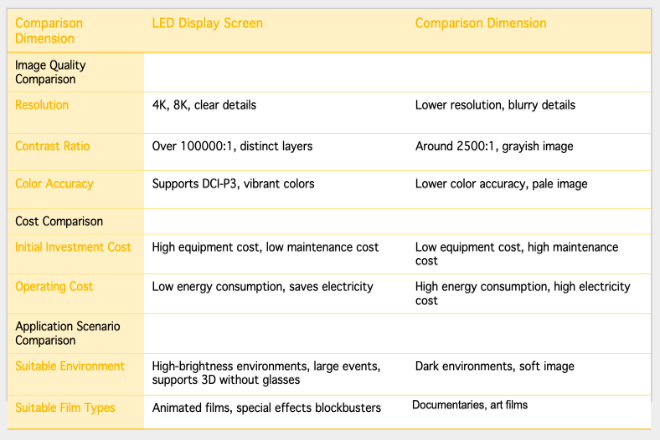
1) Comparación de la calidad de imagen
Let’s talk about picture quality first, which is what the audience cares about most.
The gap between LED screens and traditional projectors in this regard is like the difference between high-definition TVs and old-fashioned TVs.
1.1) Resolución:
The resolution of LED screens is amazingly high; 4K and 8K are optional, and the picture details are extremely clear.
For example, when watching “Avatar 2”, the corals and fish schools in the underwater world can be seen clearly in every detail.
Although traditional projectors can also play movies, the details are a bit “fuzzy”, and the picture is not so delicate.
1.2) Contraste:
The contrast of LED screens is simply amazing, reaching 100000:1 or even higher. The black of the picture is blacker, the white is whiter, and the layering is particularly strong.
The contrast of traditional projectors is generally only about 2500:1, and the picture looks a bit “grey”, especially in dark scenes.
For example, in Gotham City at night in “Batman”, traditional projectors may not let you see the details, but LED display screens can let you see every expression of Batman clearly.
1.3). Color reproduction:
LED display screens support DCI-P3’s wide colour gamut, with super high colour reproduction, and the colours in the movie can be perfectly presented.
For example, the blue skin and fantasy plants of Pandora in “Avatar” are so colourful that they seem to be right in front of you.
The colour reproduction of traditional projectors is worse, and the picture looks a bit “light” and not vivid enough.
It is also very obvious when watching movie clips.
For example, in the racing scene in “Fast and Furious”, the high refresh rate of the LED display screen makes the picture smooth like silky chocolate, and every movement of the wheel can be seen clearly.
Traditional projectors may have a little smear, and the picture is not so smooth.
For example, in the universe starry sky in “Interstellar”, the LED display screen can make every star clearly visible, while the traditional projector may be a bit blurry.
2). Cost comparison
Let’s take a look at the cost again, which is what the theatre owner cares about most.
2.1). Initial investment cost:
The equipment price of LED display screens is not cheap, and it may cost hundreds of thousands or even millions of yuan.
However, its advantage is that it has a low long-term maintenance cost and a long life. There is basically no need to change bulbs, and it is easy to maintain.
Traditional projector equipment is relatively cheap, and a set can be done for tens of thousands of yuan.
But the bulb life is short, and it needs to be replaced after a few hundred hours of use. Maintenance costs are high, and they are also considerable in the long run.
2.2). Operating cost:
LED display screen has low energy consumption and can save a lot of electricity bills. Traditional projectors have relatively high energy consumption, and electricity bills are also a considerable expense in the long run.
For example, a medium-sized cinema can save tens of thousands of electricity bills a year with LED display screens, which is not a small amount.
3). Application scenario comparison
Finally, let’s talk about the application scenario, which is the “battlefield” of LED display screens and traditional projectors.
3.1). LED display screen:
High brightness, suitable for high-brightness environments and large-scale events. For example, in outdoor concerts and live sports events, the audience can see clearly even in the sun.
Moreover, LED display screens can also achieve naked-eye 3D effects, which is particularly suitable for showing special effects blockbusters, such as “Avatar 2”, where the audience can feel a strong visual impact.
3.2). Traditional projectors:
Más adecuado para el entorno oscuro de los cines tradicionales, la imagen es suave y el público no se siente cansado.
Por ejemplo, al ver películas de arte en un cine pequeño, la calidad de imagen de los proyectores tradicionales también puede hacer que la gente se sienta cómoda.
En diferentes tipos de películas, las pantallas LED tienen ventajas obvias a la hora de reproducir dibujos animados y grandes éxitos de taquilla con efectos especiales.
Por ejemplo, en dibujos animados como “Nezha 2”, las pantallas LED pueden hacer que los colores de la imagen sean más vívidos y los detalles más ricos.
Los proyectores tradicionales también funcionan bien al reproducir documentales que no requieren tanto color y detalle.
Por ejemplo, los documentales de paisajes naturales como “Planeta Tierra” y la calidad de imagen de los proyectores tradicionales también pueden hacer que el público sienta el encanto de la naturaleza.
5. ¿Qué cambios han traído las pantallas LED a la industria cinematográfica?
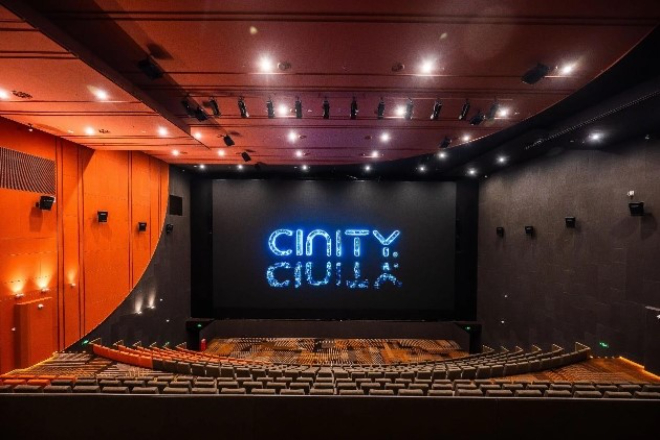
1) Impacto en la creación de contenido
El equipo de producción cinematográfica ahora tiene que pensar cuidadosamente en la alta resolución y el alto contraste de las pantallas LED.
En el pasado, al hacer películas, los detalles y colores de la imagen podían ser suficientes, pero ahora eso no es posible.
Por ejemplo, en el rodaje de “Avatar 2”, el director Cameron tuvo que esforzarse por lograr la perfección desde el rodaje hasta la postproducción para presentar el mejor efecto en la pantalla LED.
La alta resolución permite ver claramente cada cabello y cada hoja de la imagen, y el alto contraste hace que los niveles de luz y oscuridad de la imagen sean más ricos.
Esto requiere que el equipo de producción preste más atención a los detalles durante el rodaje y dedique más tiempo a la posproducción.
Además, las pantallas LED proporcionan un espacio muy amplio para la creación de películas con efectos especiales y películas inmersivas.
En el pasado, las películas con efectos especiales podían no presentarse de manera perfecta debido a limitaciones de la imagen, pero ahora, con las pantallas LED, las escenas de efectos especiales en la película pueden hacerse más realistas e impactantes.
Por ejemplo, en el cielo estrellado del universo de “Interstellar”, el público puede ver más detalles en la pantalla LED, como si estuviera viajando por el universo.
Este avance tecnológico ha dado al equipo de producción cinematográfica más espacio para jugar y ha permitido al público ver películas más emocionantes.
2) Experiencia de visualización mejorada
La sensación inmersiva y realista que ofrece la pantalla LED ha cambiado las expectativas del público sobre las películas.
En el pasado, al ver películas, los espectadores podían simplemente sentarse allí y mirar las imágenes y escuchar los sonidos, pero ahora es diferente.
Por ejemplo, al ver “Rápido y Furioso” en la pantalla LED, la escena de carreras de alta velocidad puede brindarle a la audiencia un fuerte impacto visual, como si estuvieran corriendo en un automóvil.
Esta sensación de inmersión aumenta las expectativas del público sobre la película y todos esperan ver imágenes más realistas e impactantes.
Además, la pantalla LED ofrece a los cines una variedad de modos de visualización.
Por ejemplo, en la visualización interactiva, el público puede participar en los enlaces interactivos de la película a través de teléfonos móviles o equipos en el lugar, como por ejemplo votando para decidir la dirección de la trama.
También hay conexión multipantalla, con varias pantallas en un cine, y el público puede ver la película desde diferentes ángulos.
Este novedoso modo de visualización ofrece a los espectadores más opciones y hace que ver películas sea más interesante.
3) Innovación en el modo de funcionamiento del teatro
La pantalla LED admite una variedad de formatos de contenido, lo que puede generar muchos ingresos nuevos para los cines.
Por ejemplo, para la publicidad, los cines pueden reproducir anuncios en alta definición antes de las proyecciones para atraer la atención del público.
Las transmisiones en vivo tampoco son un problema. Los eventos deportivos y los conciertos se pueden transmitir en vivo a través de pantallas LED, y el público puede disfrutar de una experiencia en vivo en el cine.
También existen los deportes electrónicos. Los cines pueden organizar competiciones de deportes electrónicos para atraer al público joven. Estas nuevas formas de contenido no solo aumentan los ingresos de los cines, sino que también los diversifican.
Además, las pantallas LED han transformado la distribución y el diseño de los cines. Antes, los cines debían reservar una sala de proyección especial y considerar la distancia y el ángulo de proyección. Ahora, con las pantallas LED, ya no hay que preocuparse por ello.
Los cines pueden diseñar salas de forma flexible según sus necesidades, como añadir asientos y configurar diferentes áreas de visualización.
Esta disposición flexible hace que la utilización del espacio en los cines sea más eficiente y ofrece al público un entorno de visualización más cómodo.
En resumen, las pantallas LED no solo mejoran las películas, sino que también hacen que verlas sea más interesante y divertido. No solo transforman la experiencia cinematográfica y visual, sino que también aportan nuevas ideas y oportunidades a las operaciones cinematográficas.
6. Conclusión
Desde la calidad de imagen hasta la experiencia, desde el costo hasta el funcionamiento, las pantallas LED están generando cambios sin precedentes en la industria cinematográfica. No solo hacen que la experiencia visual sea más impactante, sino que también brindan más posibilidades a las salas de cine.
La era de los proyectores tradicionales puede estar llegando a su fin, pero el futuro de las pantallas LED recién comienza.
Finalmente, si quieres saber más sobre las pantallas LED, Por favor póngase en contacto con nosotros.
Te puede interesar:
Otros artículos sobre pantallas LED de cine:
